As data demands increase, researchers find that stimulated Brillouin scattering, which is based on interactions between light and sound, may hold solutions.
AMOL CHOUDHARY, INDIAN INSTITUTE OF TECHNOLOGY, (IIT) DELHI, AND ELIAS GIACOUMIDIS, DUBLIN CITY UNIVERSITY
Data information is transferred across and within countries, cities, and continents at near the speed of light, and optical fibers carry most of it. Such speeds seem adequate for the current global internet backbone. However, because of the popularity of services such as Netflix and YouTube, optical fibers are now coming under huge pressure to meet the demands of increased data traffic.
Research in fiber optic networks is responding to this demand on several fronts: by moving to spatial division multiplexing where various modes of light are transmitted over the same optical fiber, or by increasing the spectral efficiency (signal bandwidth) of currently deployed single-mode fibers (SMFs) and therefore increasing the signal speed, especially when combining more efficient modulation techniques.
Whatever the method or plurality of methods, significant digital signal processing (DSP) at the transmitter and/or the receiver is essential. More particularly, the eruption of superhigh-speed coherent DSPs in which both the amplitude and phase of a transmitted optical signal can be fully recovered has dramatically changed the way modern lightwave communications systems are conceived.
Digital coherent receivers
State-of-the-art coherent DSP receivers have replaced former complex optical hardware, shifting the implementation of coherence operations to the electrical domain. The adoption of these digital coherent receivers simultaneously provides enhanced sensitivity and enables the use of advanced vectorial modulation formats with unprecedented spectral efficiencies. This has already appeared in the marketplace as commodity hardware building blocks, especially with 200/400 Gb/s solutions for metropolitan interconnect between hyperscale data centers and in-access networks.
In addition, the deployment of DSP-based coherent systems opens new possibilities to compensate channel impairments. Fiber chromatic dispersion and polarization-mode dispersion can now be tackled by exploiting the flexibility that electronics offers. However, the phase noise and the frequency drift of the employed laser sources lead to critical system performance degradation. To compensate for this crucial effect, widely known as the carrier frequency offset (CFO), additional DSP is required at the receiver, thus increasing complexity, energy, cost, and latency. Furthermore, expensive local oscillator (LO) lasers are already used at the receiver to extract the phase and amplitude information.
Among the most popular modulation techniques is orthogonal frequency division multiplexing (OFDM)1. In OFDM, each electronic subcarrier can be modulated by an advanced modulation format — for example, by 16-level quadrature amplitude modulation (16-QAM). OFDM has been widely adopted in wireless communications and cellular systems — such as Worldwide Interoperability for Microwave Access (WiMAX) and 4G — because of its simplicity and scalability. Coherent optical OFDM (CO-OFDM)2 has been recently explored for optical communications to maximize transmission capacity without sacrificing DSP computational resources. Nevertheless, the presence of CFO in CO-OFDM makes it impractical for cost- and energy-sensitive local and access networks. For this reason, self-coherent optical OFDM (SCO-OFDM)3 has been proposed to eliminate the CFO. In SCO-OFDM, the LO carrier is transmitted with the signal to eliminate the need for an external LO laser at the receiver. Yet, SCO-OFDM systems support very limited signal capacity, as they sacrifice useful spectral bandwidth to “extract” the transmitted carrier and recover the signal at the receiver.
Photonic chip-based advancements
Recent advancements of on-chip photonic signal processing for fiber optic data transmission have been very attractive for chip-scale optical interconnects, especially at the network nodes for ultracompact data management with low power consumption. Among the photonic chip-based nonlinear processing techniques, stimulated Brillouin scattering (SBS)4, which is based on the interactions between light and sound, has held attention because of its remarkable concurrent property of narrowband filtering with very-high-gain amplification.
This concurrent property can be very useful for carrier recovery in next-generation SCO-OFDM systems to eliminate the need for a wide spectral carrier guard band and provide enough carrier gain for demodulating OFDM subcarriers that support higher-order modulation formats (e.g., 16/64-QAM). By applying chip-based SBS
processing5 on SCO-OFDM, limitations presented in benchmark solutions in terms of speed, cost, energy, and latency can be resolved.
SBS-based filtering
In SBS, a strong “pump” beam interacts with a counterpropagating weak “probe” beam, which results in a moving acoustic grating formed through electrostriction and the photoelastic effect. This leads to Doppler-shifted waves known as Stokes waves. This process can be initiated through thermal noise and can be self-stimulated through a positive feedback because of the generated acoustic waves (also known as sound waves). Typically, SBS is a nuisance for telecommunications, since a large fraction of the pump can be reflected and thus lost.
The conservation of energy and momentum requires the frequencies ka, kp, and ks and the wave vectors ka, kp, and ks, to satisfy Equations 1 and 2.
The subscripts a, p, and s represent the acoustic, pump, and Stokes waves, respectively. For experiments, chalcogenide waveguides were used as the Brillouin medium since the SBS gain is ~500× larger when compared to a standard SMF. This is because chalcogenide glasses have a high refractive index of ~2.4 (the SBS gain scales as the eighth power of the refractive index), low propagation losses, small mode areas, and, critically, a high overlap of the optical and acoustic modes. All of these factors enable a strong interaction between the photons and the acoustic phonons in the waveguides, thus promoting strong SBS.
Hereafter, harnessing large-gain SBS in a chalcogenide photonic chip delivers ultrahigh-resolution carrier filtering and regeneration for applications in carrier recovery of high-capacity self-coherent optical signals, without need for a separate LO laser at the receiver or CFO estimation. Such ultrahigh-resolution carrier filtering/regeneration can increase the OFDM capacity by reducing the guard band between the carrier and the OFDM band at a record low ~265 MHz5.
On-chip SBS allows the demonstration of a high-performance “self-tracking” narrowband filter amplifier without the need for additional electronics (e.g., analog loops), thus reducing the system complexity. In the system setup configuration at the transmitter side, a typical self-coherent approach is maintained, generating an off-
line 116.82-Gb/s 16-QAM SCO-OFDM signal using an arbitrary waveform generator (AWG) (Figure 1).
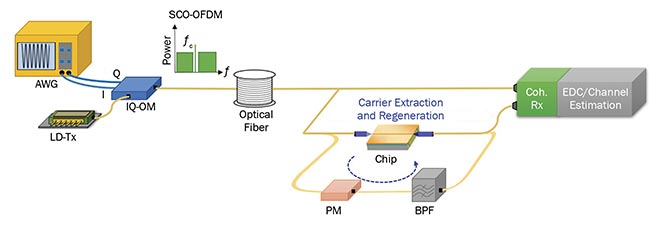
Figure 1. Transmission setup using SCO-OFDM with SBS chip-based processing. BPF: bandpass filter; LD-Tx: laser diode transmitter; Coh. Rx: coherent receiver. Images adapted from Reference 5 and courtesy of Amol Choudhary and Elias Giacoumidis.
The signal has a high carrier-to-
signal ratio and a narrow guard band in
the middle of the frequency band to place
the carrier (i.e., 127 useful subcarriers and
one in the middle are dropped for placing the carrier, as shown in Figure 2). Using an in-phase/quadrature-phase (real data/phase data) optical modulator (IQ-OM) driven by a laser diode (LD), the complex electrical signal is converted to optical and then transmitted over a commercial SMF of
40 km.
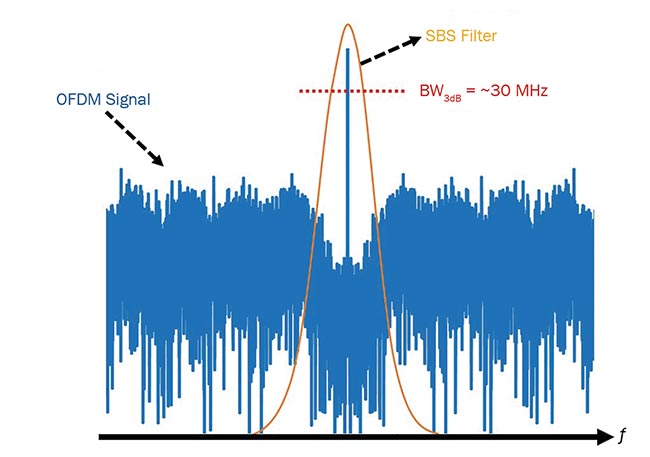
Figure 2. Filtering of a SCO-OFDM signal carrier with a carrier guard band of ~256 MHz using SBS. BW: bandwidth. Images adapted from Reference 5 and courtesy of Amol Choudhary and Elias Giacoumidis.
At the receiver end, the signal is divided into two branches. In the first branch, the whole OFDM signal goes directly to the coherent homodyne receiver, while the second branch is responsible for extracting the carrier from the signal to use it as an LO at the coherent receiver. In the second path, the SBS device acts as a “self-tracking” filter amplifier for the transmitted optical carrier, and the shape of the SBS filter is Lorentzian along with the SCO-OFDM signal (Figure 2).
The self-tracking SBS filter is achieved through the configuration shown in Figure 1: The signal is split and frequency up-shifted using a phase modulator (PM) and a filter, which is then counterpropagated with the signal to provide narrowband gain to the signal via the SBS effect. Therefore, any frequency drifts of the laser are followed by the frequency drift of the filter. At the photoreceiver, the mixing product between the extracted LO and the signal will not suffer from any drift in the RF (radio frequency) domain, thus nullifying the requirement for CFO compensation.
The SBS shift was measured in the chip to be ~7.7 GHz, while the measured ~3 dB bandwidth was ~30 MHz, as seen in Figure 2. The relationship between the signal bit rate of the SCO-OFDM system and the number of subcarriers, which is related to the useful spectral band, is given in Equations 3 and 4.
Here, Sk is the signal bit rate of the k-th subcarrier, Ms is the total number of subcarriers, nk is number of binary bits transported by the k-th OFDM subcarrier in one symbol period Ts, and rs is the sampling rate. Value p includes: 1) a cyclic prefix (time-domain guard band) to increase the intersymbol interference tolerance, and 2) pilot-subcarriers for electronic dispersion compensation (EDC) and CFO estimation. Clearly, because of the absence of extra pilot subcarriers for CFO estimation, the signal bit rate in SCO-OFDM can still be maximized by only sacrificing one middle OFDM subcarrier. (See Equations 3 and 4.)
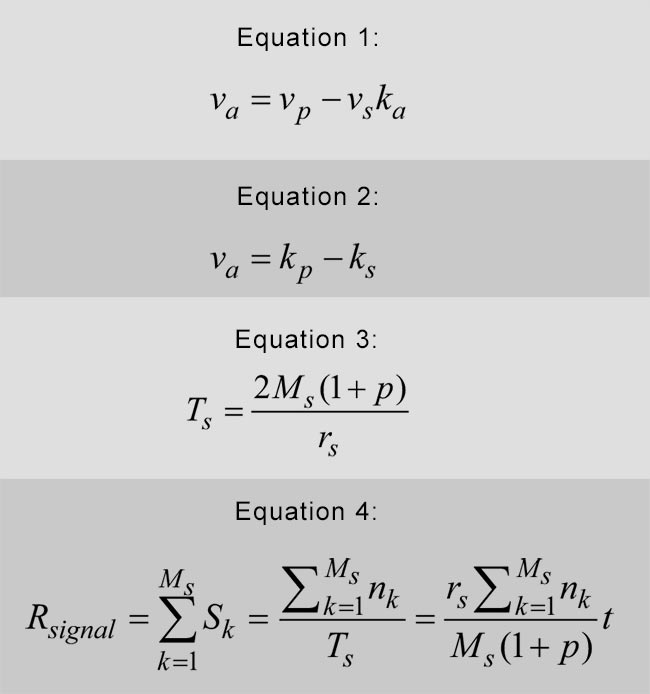
The performance of the proposed self-coherent optical system is shown in comparison to a similar system in which SBS is processed over a 4.46-km-long SMF (Figure 3). The quality (Q)-factor of a few subcarriers around the middle zero subcarrier (which is around the carrier spectral guard band) is degraded compared to the chip-based SBS approach. This is because SBS processing over an SMF is more unstable compared to the very short length of the chip, thus causing a small frequency offset of the carrier that degrades the performance of six neighbor frequency subcarriers. Our SBS-based SCO-OFDM
system also shows negligible penalty when compared to the benchmark CO-OFDM system. Complete on-chip integration of SBS-self-coherent receivers could potentially further reduce the size, weight, and power (SWaP).
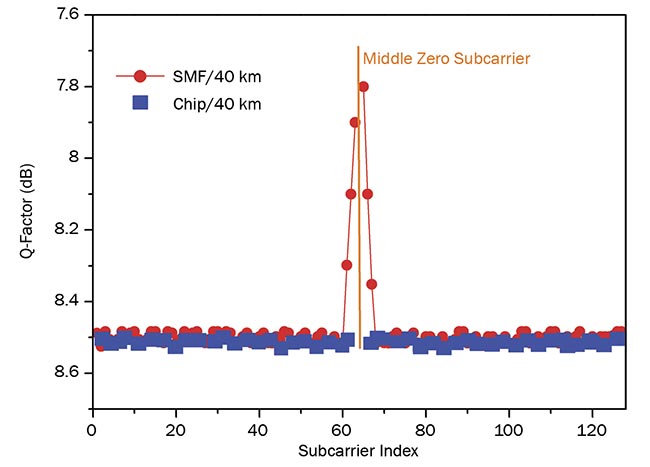
Figure 3. Per subcarrier Q-factor for a total of 127 subcarriers when SBS is processed on a chip and over an SMF. Images adapted from Reference 5 and courtesy of Amol Choudhary and Elias Giacoumidis.
The future
Growth in the development of on-chip SBS devices has been tremendous, which could potentially offer integration of high-SBS-gain waveguides. By bringing critical active devices (e.g., a photoreceiver, electro-optic modulator, or amplifier) together on a single chip, extreme stability and low-cost mass production is enabled (Figure 4). Finally, recent advancements in machine learning for coherent optical receivers6 have shown that the Q-factor for each OFDM subcarrier can be enhanced. We thus envisage that merging photonic chips with digital-based machine learning will provide practical self-coherent systems for energy-efficient long-haul transmission.
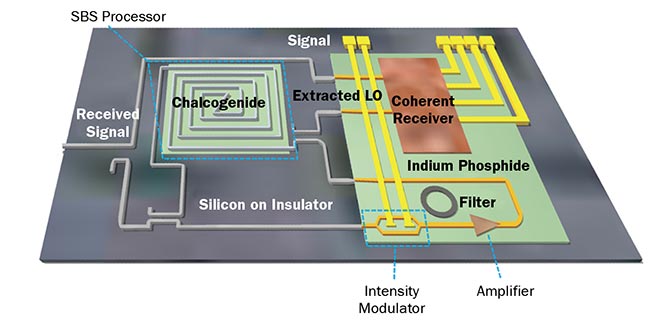
Figure 4. An envisioned integrated photonic-chip-based solution, including self-coherent carrier recovery and detection. Images adapted from Reference 5 and courtesy of Amol Choudhary and Elias Giacoumidis.
On-chip SBS for self-coherent carrier recovery could be implemented in a broad variety of applications to meet the imminent high capacity and energy-efficiency demands. The proposed filter amplifier can be deployed for carrier recovery in other important applications, such as in very long-baseline interferometry and phase reference sharing for quantum key distribution (QKD) applications.
Meet the authors
Amol Choudhary is with the Department of Electrical Engineering of the Indian Institute of Technology Delhi. Previously, he was a DECRA (Discovery Early Career Researcher Award) Fellow at the University of Sydney and an EPSRC (Engineering and Physical Sciences Research Council) Doctoral Prize Fellow at the University of Southampton, where he received his doctorate.
Elias Giacoumidis is a Marie Sklodowska-Curie Research Fellow at Dublin City University and the CONNECT Science Foundation Ireland Research Centre in Dublin. Previously,
he was a research fellow at Heriot-Watt University and a deputy project leader at the University of Sydney.
References
1. S. Weinstein and P. Ebert (1971). Data transmission by frequency-division multiplexing using the discrete Fourier transform. IEEE Trans Commun Techn, Vol. 19, No. 5,
pp. 628-634.
2. E. Giacoumidis et al. (2014). Dual-polarization multi-band OFDM transmission and transceiver limitations for up to 500 Gb/s in uncompensated long-haul links. Opt Express, Vol. 22, No. 9, pp. 10975-10986.
3. M. Sjodin et al. (2008). Filter optimization for self-homodyne coherent WDM systems using interleaved polarization division multiplexing. J Lightwave Technol, Vol. 29, No. 6, pp. 1219-1226.
4. A. Choudhary et al. (2017). Advanced
integrated microwave signal processing with giant on-chip Brillouin gain. J Lightwave Technol (Invited), Vol. 35, No. 4,
pp. 846-854.
5. E. Giacoumidis et al. (2018). Chip-based Brillouin processing for carrier recovery in coherent optical communications. Optica, Vol. 5, Issue 10, pp. 1191-1199.
6. E. Giacoumidis et al. (2018). Unsupervised support vector machines for nonlinear blind equalization in CO-OFDM. IEEE Photonics Technol Lett, Vol. 30, No. 12,
pp. 1091-1094.